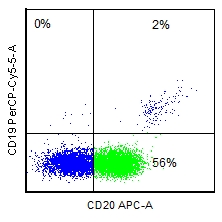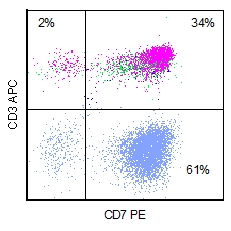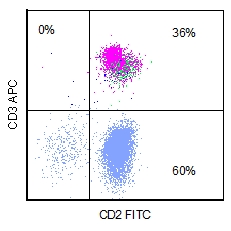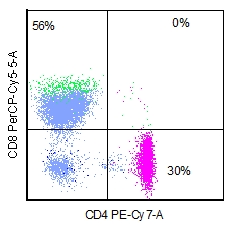CD20 Positive T Cell Lymphoma
You are here
Definition
T-cell Lymphomas describe a diverse group of blood cancers that originate from T-cells. However, CD20 expression in T Cell Lymphoma is a rare occurence that has been reported in literature.
Sample Cases
Click here for instructions on how to download the free FCS Express Reader to view and manipulate the sample cases.
| Case Name (click to open) | Comments | Size |
| CD20PosTL.fey | CD20+ t cell lymphoma showing aberrant T cell expression with dim CD20 expression. Special Thanks to Carol Moore for providing the data files! | 6.23 MB |
Generally, T cell Lymphoma is uncommon, occurring in about 10% of all non-Hodgkins Lymphomas. CD20 positive t cell lymphoma represents a small fraction of t cell lymphomas. It is more common in adults than children.Epidemiology
Possible Causes
The pathogenesis of CD20+ T cell lymphoma is not known. CD20 is a transmembrane protein that was first identified as a B cell marker in 1980. CD20 appears early in B cell development and remains present through the Plasma Cell stage of development. Hultin and colleagues have described dim CD20 expression on normal T cells in some individuals. It is possible that the CD20+ T cell lymphoma arises from this subpopulation of normal T cells that have undergone a neoplastic transformation.
Morphology
According to the literature, all the cases in the study presented with a hypercellular marrow with interstitial lymphocytic infiltrates. The infiltrating lymphocytes were small to medium-sized with a small amount of cytoplasm, slightly irregularly shaped nuclei and inconspicuous nucleoli.
 |
| Morphology of CD20+ T cell Lymphoma |
Immunophenotyping
The immunophenotype of CD20 positive T Cell Lymphoma is similar to other T cell malignancies, except for the presence of the CD20 protein. These neoplasms typically express CD2, CD4, CD5, CD8 and with varying degrees of CD7 and a decrease or absence of CD3 expression.
 |
 |
 |
 |
| In this case, the Lymphocytes show a predominant population with dim CD20 expression, while being negative for CD19. | The Lymphocytes also show a population of T Cells that express CD7, but not CD3. | These same cells also co-express CD2. | A CD8 dim population is apparent. |
References
Imai M, Jiang JG, Wu Z, Dabbas B, Ni H. "CD20-positive T-cell lymphoma involving bone marrow: report of four cases" Journal of Hematopathology, ISSN 1868-9256, 26 February 2013. DOI 10.1007/s12308-013-0177-9
http://link.springer.com/article/10.1007%2Fs12308-013-0177-9#page-1
Sun T, Akalin A, Rodacker M, Braun T. "CD20 positive T cell lymphoma: is it a real entity?" Journal of Clinical Pathology 2004 April; 57(4): 442-444. DOI 10.1136/jcp.2003.011734
http://www.ncbi.nlm.nih.gov/pmc/articles/PMC1770255/?report=classic
Buckner C, Christiansen L, Bourgeois D, Lazarchick JJ, Lazarchick J. "Case Reports: CD20 Positive Lymphoma/Leukemia: A Rare Entity with Diagnostic Pitfalls" Annals of Clinical and Laboratory Science, vol 37, no. 3, 2007: 263-267
http://www.annclinlabsci.org/content...3/263.full.pdf
